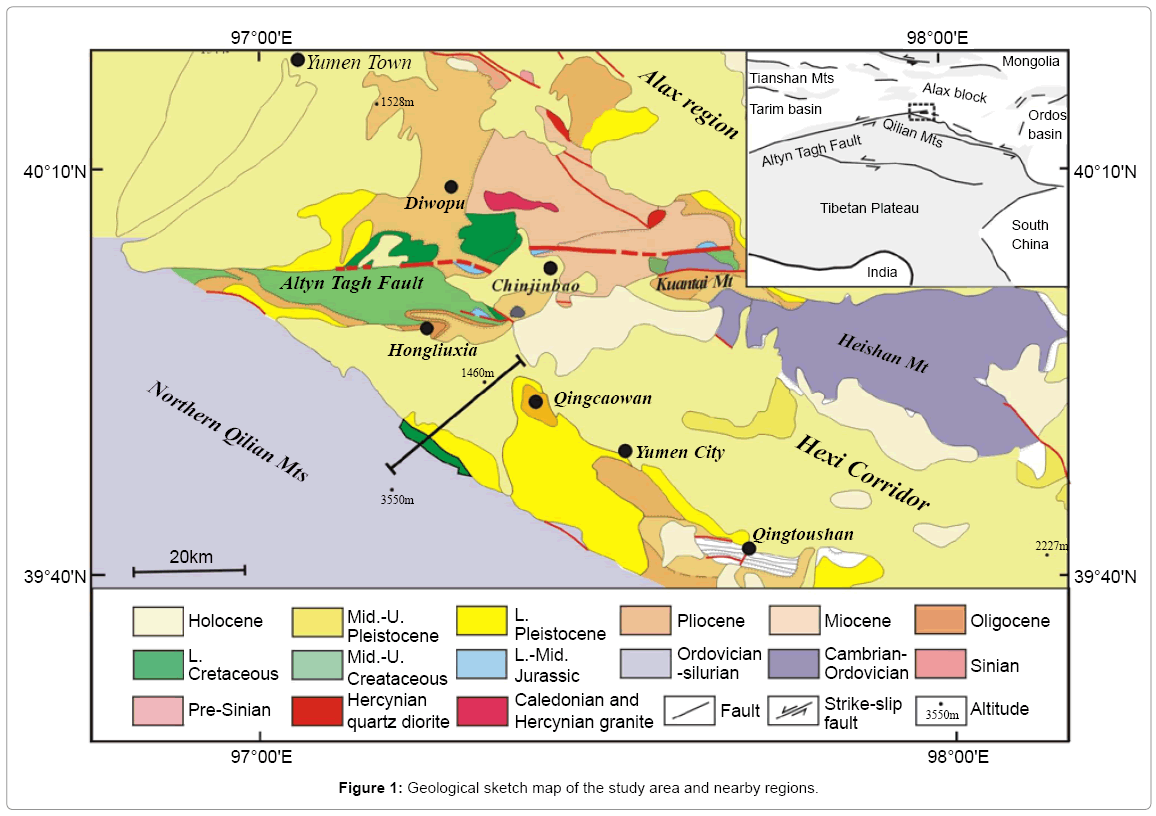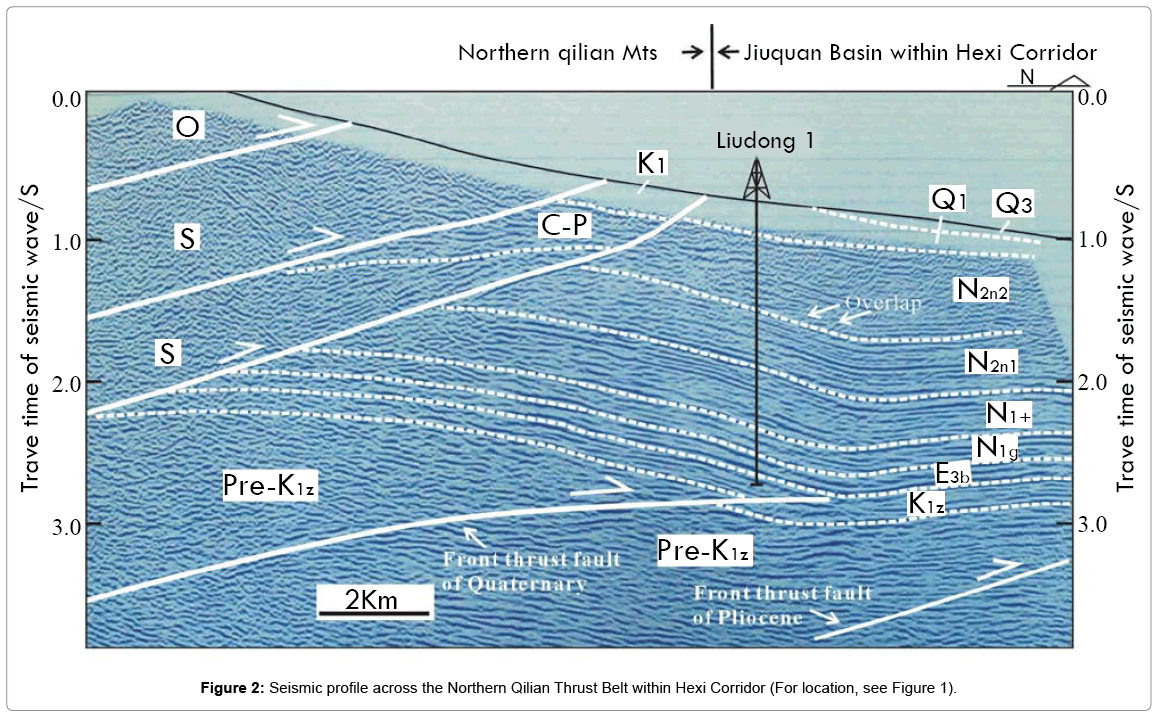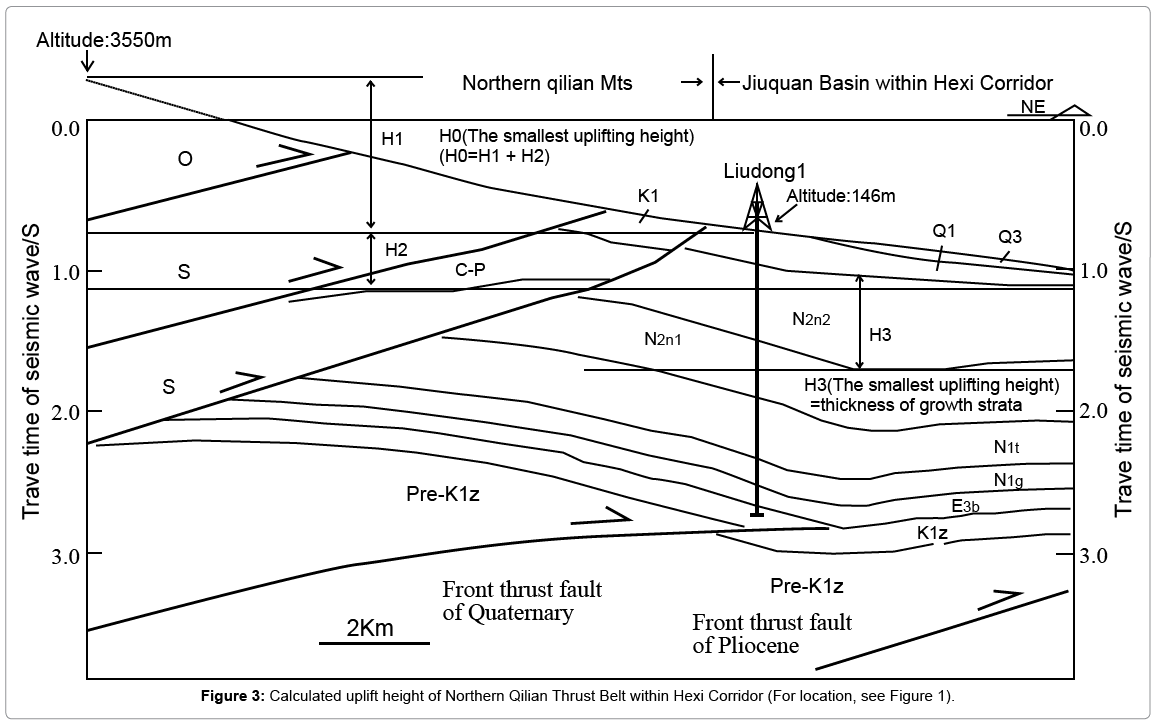Seismic Constraints on Central Asian Evolution of Late Cenozoic: Uplift Rates and Two-Stage Evolution of the Northern Tibetan Plateau, China
Received: 30-May-2013 / Accepted Date: 18-Aug-2013 / Published Date: 23-Aug-2013 DOI: 10.4172/2157-7617.1000152
Abstract
In order to better understand the Cenozoic uplift history of the Tibetan Plateau resultant from the Indo-Asian collision, we carried out a study of 2D seismic profile for petroleum exploration across the Northern Qilian Thrust Belt near/within the Hexi Corridor, northern margin of the Tibetan Plateau. We found the two-stage uplift of the Northern Qilian Orogenic Zone in Late Cenozoic. The first stage was in the Late Pliocene, the uplift rate of the Northern Qilian Orogenic Zone was ≥ 1.7mm/a, and the northern margin/front thrust fault of the Northern Qilian Thrust Belt reached at the central Hexi Corridor, indicating the general emergence and horizontal propagation period. The second stage was during the Late Pleistocene, the uplift rate of the Northern Qilian Orogenic Zone was ≥ 3.7 mm/a, but the northern margin/front thrust fault of the Northern Qilian Thrust Belt retreated back to the southern Hexi Corridor, indicating the main uplift period. This result provides a foundation for future work to study the uplift history of the Tibetan Plateau, China.
Keywords: Uplift rate; Two-stage evolution; Growth strata; Tibetan plateau; Northern qilian thrust belt; Hexi corridor
Introduction
The Tibetan Plateau, also known as the Qinghai-Tibetan (Qingzang) Plateau, is the world's highest and largest plateau with an average elevation exceeding 4,500 meters (14,800 ft) and an area of 2,500,000 square kilometers (970,000 sq mi) (Figure 1). The uplift history of this Plateau is important because of its effect on regional and global climate during Cenozoic time [1], and its uplift dynamics related to the Indo-Asian collision [2,3]. The uplift of the Tibetan plateau is a multi-stage process, including three stages of slow uplift (10.0-6.0 Ma), transitional uplift (6.0-2.5 Ma) and rapid uplift (since 2.5 Ma) [4,5]. During Eocene time, the northern boundary of this plateau was in the Tanggula Shan, and expanded throughout the Neogene toward its present northern margins in the Qilian Shan [6], and the southern Tibet Plateau began uplift at similar to 5.89 Ma, later than the northern Tibetan Plateau, and the strong uplift took place at similar to 5.15 and similar to 2.71 Ma, with the uplift peaking at similar to 2.71 Ma [7]. The Tibetan plateau grew in somewhat by accretion of Cenozoic foreland basins such as the Hoh Xil basin, Qaidam basin and Jiuquan basin during 49-23 Ma, 46-2.45 Ma and 29.5-0 Ma respectively to its northern margin [8]. Along the Allyn Tagh Fault the accumulation of molasses deposits began ca. 13.7 Ma ago due to the tectonic uplift of the Tibetan Plateau, a process that continued until at least 9 Ma ago [9].The change in depositional facies was accompanied by an increase in sedimentation rate from an average similar to 0.15 mm/yr between the earliest Oligocene and the earliest Pliocene to 1.4 mm/yr in the Gauss normal Chron (3.6-2.6 Ma), indicating that the main uplift of the northwestern Tibetan Plateau began ca. 4.5 Ma [10].
However, the Late Cenozoic uplift history of this Plateau is still controversial for lack of convincing quantitative evidence. In this paper, the 2D seismic profiles for petroleum exploration across the Northern Qilian Thrust Belt near/within the Hexi Corridor, northern margin of the Tibetan Plateau were used to trace the quantitative uplift of the Tibetan Plateau, western China. The strata on the seismic profiles is calibrated by the data from the nearby drilling holes and geological outcrop.
The Hexi Corridor and Northern Qilian Thrust Belt
The Hexi Corridor is the north-most foreland basin of the Tibetan Plateau with a length of about 1000-1200 km and its formation is controlled by the Altyn Tagh Fault, northern marginal faults of North Qilian Orogenic Zone, and the Kuantai Shan-Longshou Shan Fault (Figure 1). In Late Cenozoic, the Northern Qilian Orogenic Zone (NQOZ) thrust violently over the Hexi Corridor, and a Northern Qilian Thrust Belt developed within the Hexi Corridor. The Hexi Corridor and Northern Qilian Thrust Belt contain rocks ranging in age from Archean to Pliocene. The Archean-Lower Paleozoic basement units are composed of the Metamorphic or marine clastic rocks, carbonate and Volcano rocks. Sedimentary sequences in the Hexi Corridor and Northern Qilian Thrust Belt include Lower-Middle Jurassic sandstone-pebble conglomerate (J1-2), widespread Lower Cretaceous sandstone and mudstone, Tertiary sandstone and conglomerate, and the loose deposits of the Quaternary (Q). From the Lower to the Upper, the Lower Cretaceous includes Chijinbao (K1c), Xiagou (K1g) and Zhonggou(K1z) Formations respectively. The Tertiary is composed of the Paleocene-Eocene Liugouzhuang (E1-2L), Oligocene Huosaogou (E3h) and Baiyanghe (E3b) Formations, Miocene Gongxingshan (N1g) and Getanggou (N1t) Formations, Pliocene Niugetao Formation (N2n), Lower-Middle Pleistocene (Q1y) and Jiuquan (Q2J) Formations, as well as Upper Pleistocene and Holocene aeolian and glacial deposits (Q3+4).
The Northern Qilian thrust belt is particularly a good place to trace the Late Cenozoic uplifting history of the Tibetan Plateau because of its location of the northern margin of the Tibetan Plateau.
The Northern Qilian Orogenic Zone
The Northern Qilian Orogenic Zone (NQOZ), located between the Qaidam basin and the Hexi Corridor, is a Caledonian, Indosinian and Himalayan intraplate orogenic zone in NW China (Figure 1). In Late Cenozoic, it uplifted rapidly and thrust northward over the Hexi Corridor due to the Indo-Asian collision [2,3].
The Northern Qilian Orogenic Zone (NQOZ) contains rocks ranging in age from Archean to Pliocene. The Archean-Upper Paleozoic basement units are composed of the Metamorphic or marine Siliceous rocks, flysch and molasses deposits, carbonate and Volcano rocks [11].
Sedimentary sequences in the Northern Qilian Orogenic Zone (NQOZ) include Triassic, Lower to Middle Jurassic and Lower Cretaceous mudstone, coal beds and sandstone-pebble conglomerate.
Uplift Rates and Two-Stage Evolution of the Northern Tibetan Plateau
Two-stage uplift
The 2D seismic profile for petroleum exploration across the Northern Qilian Thrust Belt near/within the Hexi Corridor, northern margin of the Tibetan Plateau displays clearly the growth strata of Upper Pliocene and the thrust of Lower Cretaceous over the Quaternary, indicating the two-stage uplift of the Northern Qilian Orogenic Zone in Late Cenozoic.
The growth strata of Upper Pliocene Niugetao Formation (N2n2), developed to the north of the drilling hole named Liudong1, are expressed by the overlap sedimentary of the Upper Pliocene toward the North Qilian Orogenic Zone, indicating an uplift of the North Qilian Orogenic Zone in the Late Pliocene while the Lower Pliocene Niugetao Formation (N2n1) shows a steady sedimentation from the north to the south, suggesting that thrust northward and uplift of the North Qilian Orogenic Zone, did not occur during the Early Pliocene (Figure 1).
Moreover, the above 2D seismic profile for petroleum exploration also displays clearly the thrust from the northern of the Lower Cretaceous (K1) over the Lower and Upper Pleistocene (Q1,Q3), indicating another uplift of the Northern Qilian Orogenic Zone in Quaternary.
Uplift rates
The uplift height and rates of the Northern Qilian Orogenic Zone in Late Cenozoic can be calculated by the growth strata height and altitude of strata on the above 2D seismic profile for petroleum exploration, as well as the altitude on geological map and the data of drilling hole. For example, the smallest uplift height (H0) and rates (S1) of the Northern Qilian Orogenic Zone in Late Pleistocene can be calculated respectively.
H1=3550-1460 (wellhead altitude of the drilling hole named Liudong1) =2090 m
H2=0.4s×3800 m/s (travel velocity of seismic wave)/2=760 m
H0= H1+H2=2090 m+760 m=2850 m
S1=H0/180 Ma=2850/(78.1-1) Ma=3.7 mm/a
On the other hand, the smallest uplift height (H3) and rates (S2) of the Northern Qilian Orogenic Zone in Late Pliocene can be calculated respectively.
H3= The thickness of growth strata of Upper Pliocene Niugetao Formation (N2n2)
=0.7s×3800 m/s(travel velocity of seismic wave)/2=1330 m
S2=H3/(258.8-180.6) Ma=1330 m/78.2 Ma=1.7 mm/a
Thus, the uplift rate of the Northern Qilian Orogenic Zone was ≥1.7 mm/a during the Late Pliocene, and ≥ 3.7 mm/a during the Late Pleistocene.
Shifting of Northern margin fault of the Northern Tibetan Plateau
The above 2D seismic profile for petroleum exploration across the Northern Qilian Thrust Belt near/within the Hexi Corridor, northern margin of the Tibetan Plateau also displays clearly the different northern margin of the Northern Qilian Thrust Belt during the Late Pliocene and Late Pleistocene respectively. The northern margin of the Northern Qilian Thrust Belt of the Late Pliocene was expressed by the front thrust fault, which is located within central Hexi Corridor, north of the drilling hole named liudong (Figures 2 and 3). However, During the Late Pleistocene, the front thrust fault of the Northern Qilian Thrust Belt shifted southward within southern Hexi Corridor, near the drilling hole named liudong1 (Figures 2 and 3).
Thus, during the Pliocene, the front thrust fault of the Northern Qilian Thrust Belt reached at the central Hexi Corridor, indicating the general emergence and horizontal propagation period. However, during the Quaternary, the front thrust fault retreated back to the southern Hexi Corridor, indicating the main uplift period.
Conclusions
This study provides a foundation for future work to study the uplift history of the Tibetan Plateau, China. In this study, the petroleum seismic profiles across the Northern Qilian Thrust Belt near/within the Hexi Corridor, northern margin of the Tibetan Plateau were used to trace the two-stage uplift of the Northern Qilian Orogenic Zone in Late Cenozoic. The first stage uplift, occurred in the Late Pliocene, was expressed by the growth strata of the Upper Pliocene with an uplift rate of ≥ 1.7 mm/a, and the front thrust fault of the Northern Qilian Thrust Belt reached at the central Hexi Corridor, indicating the general emergence and horizontal propagation period of the Northern Qilian Orogenic Zone. These results show the two-stage uplift of the Northern Qilian Orogenic Zone because of the collision between India and Asia during the Late Cenozoic, and thus resolve the long-standing dispute over the Late Cenozoic uplift history of the Tibetan Plateau.
Acknowledgements
This study was supported by Yumen Oil field Company. We thank Yongke Han, Jianjun Chen, Jun Wei and Jianli Li at Yumen Oilfield Company of CNPC for their thoughtful reviews or kind help.
References
- Dai SA, Fang XM, Song CH, Gao JP, Gao DL, et al. (2005) Early tectonic uplift of the northern Tibetan Plateau. Chinese Sci Bullet 50: 1642-1652.
- Molnar P, Tapponnier P (1975) Cenozoic tectonics of Asia: effects of a continental collision. Science 189: 419-426.
- Tapponnier P, Molnar P (1976) Slip line field theory and large-scale continental tectonics. Nature 284: 319-324.
- Fu RS, Li LG, Huang JH, Xu YM, Chang, XH (1999) Three-step model of the Qinghai-Xizang Plateau uplift. Chi J Geophy 42: 609-616.
- Li XZ, Dong GR, Chen HH, Zheng HB, Jin HL (2001) Uplift processes for the Qinghai-Tibet Plateau: A comparative study of Yecheng section and Siwalik group. Chi Sci Bullet 46: 108-113.
- Wang CS, Zhao XX, Liu ZF, Lippert PC, Graham SA, et al. (2008) Constraints on the early uplift history of the Tibetan Plateau. Proceedings of the National Academy of Sciences of the United States of America, 105: 4987-4992.
- Meng XG, Zhu DG, Shao ZG, Yang CB, Han JN, et al. (2008) Late Cenozoic stratigraphy and paleomagnetic chronology of the Zanda basin, Tibet, and records of the uplift of the Qinghai-Tibet Plateau. Acta Geologica Sinica-English Edition, 82: 63-72.
- Zhu Ld, Wang CS, Zheng HB, Xiang F, Yi HS, et al. (2006) Tectonic and sedimentary evolution of basins in the northeast of Qinghai-Tibet Plateau and their implication for the northward growth of the plateau. Palaeography, Plaeoclimatology and Palaeocology, 241: 49-60.
- Sun JM, Zhu RX, An ZS (2005) Tectonic uplift in the northern Tibetan Plateau since 13.7 Ma ago inferred from molasse deposits along the Altyn Tagh Fault. Earth Planet Sci Lett 235: 641-653.
- Zheng HB, Powell CM, An ZS, Zhou J, Dong GR (2000) Pliocene uplift of the northern Tibetan Plateau. Geo 28: 715-718.
- Du YS, Zhu J, Xu YJ (2009) Sedimentary geology of Northern Qilian Orogenic Zone of Caledonian-Early Hercynian. Beijing: Press of China University of Geosci 7: 115.
Citation: He G, Pang K (2013) Seismic Constraints on Central Asian Evolution of Late Cenozoic: Uplift Rates and Two-Stage Evolution of the Northern Tibetan Plateau, China. J Earth Sci Clim Change 4: 152. Doi: 10.4172/2157-7617.1000152
Copyright: ©2013 He G, et al. This is an open-access article distributed under the terms of the Creative Commons Attribution License, which permits unrestricted use, distribution, and reproduction in any medium, provided the original author and source are credited.
Share This Article
Open Access Journals
Article Tools
Article Usage
- Total views: 14401
- [From(publication date): 10-2013 - Apr 20, 2024]
- Breakdown by view type
- HTML page views: 9915
- PDF downloads: 4486



